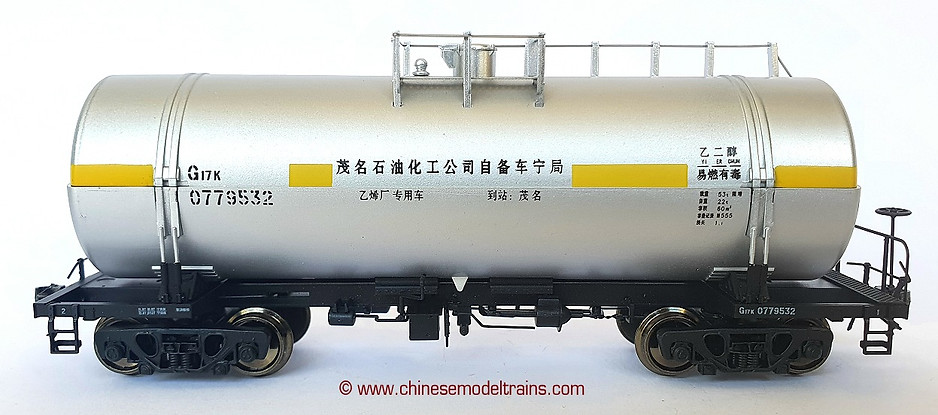
The complete listing of Chinese prototype models is below. For model reviews, please scroll below the table or click here
The complete listing of Chinese prototype models is below. For model reviews, please scroll below the table or click here
The complete listing of Chinese prototype models is below. For model reviews, please scroll below the table or click here
The complete listing of Chinese prototype models is below. For model reviews, please scroll below the table or click here
G17K
1:87 Scale

Rating
9/10
G17K Class Tank Car
Orangutan
Prototype Information
The G17's began to be mass produced from 1966 and were still being manufactured well into the late 1980's until the G60 arrived (which was based on the G17). The G17 has an empty weight of 23 tons and can carry a maximum of 52 tons. There have been nearly a dozen variants built, usually to cater for a specific liquid cargo - whether light oil, gasoline, heavy oil or asphalt. The version Orangutan has based their model on is the G17K, which rides on higher speed bogies (the 'K' referring to 'Kuai / 快', meaning 'fast'). Many G17's have been gradually retired for over 20 years and while a good number still remain in service, they are quickly falling to their much younger G60, G70 and G75 brethren.

General Information

Orangutan has provided a whopping 23 versions of their G17K tank cars, including six different liveries. They are a highly detailed plastic model with metal wheels. Prices represent extremely good value and retail in China for between 178 and 199rmb. These are the first true tank car to fit in with the early steam era (G60's are also realistic for later steam days and G70's to an extent for modern day steam).






Packaging
The packaging consists of a solid open single piece box with a cardboard sleeve. Inside the model sits a two piece plastic clam shell wrapped in a soft sheet of plastic. Each box is labeled with the specific model inside. There are no spare parts or paper work included.

Details
For the price point, Orangutan has provided a real gem for us. They are packed with details and built to a very high standard. Detail parts are either plastic or metal.

End ladders, handrails and uncoupling rods are steel. The walkways are etched metal and look incredible. Plastic parts include park brake wheel, air hoses, footsteps, air vent and a full undercarriage including brake equipment & unloading equipment. The tank straps are also plastic, unlike XingXing/Orangutan's earlier G60's which had metal ones and were plagued with problems. The tank hatch can be in the open or closed position.

Paint work is extremely good - the black and yellow versions have a very nice matt finish and the silver metallic versions have very fine metallic grain. Lettering is very sharp and legible, even on the miniscule data panels, with no faded or misprinted characters. There is a lot of individuality between the different road numbers. Unfortunately many of the popular colors have only one road number available.

Some of my wagons have tell-tale white super glue stains, predominantly around the foot step areas at each corner of the wagon where it is evident some repair work was undertaken at the factory, but asides from this they are all built very well.

Performance
The wheels are metal and are chemically darkened. Bogies are mounted to the frame with screws and pivot well with a slight amount of vertical play. They roll extremely freely.

Couplers
The cars are fitted with metal knuckle couplers, copies of Kadee #5's. They work very well, however I much prefer scale head knuckle couplers on mine and #58's are a drop in conversion. Orangutan's coupler box has an internal spring mechanism as part of the coupler box plate, so Kadee's copper spring plate or whisker couplers aren't necessary. Simply remove the screw from the coupler box, replace the coupler and reattach. I also remove the magnetic pin on my couplers for a better aesthetic look. Note, all the photos in this review show the retrofitted couplers.
